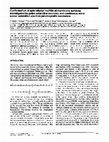Papers by Wojciech Froncisz

Review of Scientific Instruments, 2007
A loop-gap resonator (LGR) and a cylindrical TE(011) cavity resonator for use at W band, 94 GHz, ... more A loop-gap resonator (LGR) and a cylindrical TE(011) cavity resonator for use at W band, 94 GHz, have been designed and characterized using the Ansoft (Pittsburgh, PA) high frequency structure simulator (HFSS; Version 10.0). Field modulation penetration was analyzed using Ansoft MAXWELL 3D (Version 11.0). Optimizing both resonators to the same sample sizes shows that EPR signal intensities of the LGR and TE(011) are similar. The 3 dB bandwidth of the LGR, on the order of 1 GHz, is a new advantage for high frequency experiments. Ultraprecision electric discharge machining (EDM) was used to fabricate the resonators from silver. The TE(011) cavity has slots that are cut into the body to allow penetration of 100 kHz field modulation. The resonator body is embedded in graphite, also cut by EDM techniques, for a combination of reasons that include (i) reduced microwave leakage and improved TE(011) mode purity, (ii) field modulation penetration, (iii) structural support for the cavity body, and (iv) machinability by EDM. Both resonators use a slotted iris. Variable coupling is provided by a three-stub tuning element. A collet system designed to hold sample tubes has been implemented, increasing repeatability of sample placement and reducing sample vibration noise. Initial results include multiquantum experiments up to 9Q using the LGR to examine 1 mM 2,2,6,6-tetramethylpiperidine-1-oxyl (TEMPO) in aqueous solution at room temperature and field modulation experiments using the TE(011) cavity to obtain an EPR spectrum of 1 microM TEMPO.
Applied Magnetic Resonance, 2021
This article presents an analysis of spurious signals’ influence on automatic frequency control (... more This article presents an analysis of spurious signals’ influence on automatic frequency control (AFC) in EPR spectrometers. The primary source of spurious signals is leakage across the circulator in the microwave bridge. Additionally, the signals reflected from connectors in the line between the circulator and the resonator modify that signal. Spurious signals may degrade the performance of AFC, significantly offsetting lock points from the center frequency of the resonator. The offset’s size depends on the parameters of the resonator and the amount of the circulator isolation. It can be minimized by the appropriate use of a phase shifter located in the line between the circulator and the resonator. Another way to avoid these problems is to introduce a leakage compensation arm to the microwave bridge.

Biophysical Journal, 1989
Melittin spin-labeled specifically with a nitroxide at positions 7, 21, 23, or the amino terminus... more Melittin spin-labeled specifically with a nitroxide at positions 7, 21, 23, or the amino terminus was bound to phospholipid membranes, and the exposure of the spin label to the aqueous phase was investigated by measurement of Heisenberg exchange with chromium oxalate in the solution. The exchange frequency was determined by saturation recovery electron paramagnetic resonance (EPR) using a loop-gap resonator. This method allows use of very low concentrations (<1 mM) of chromium oxalate compared with conventional measurements of EPR line broadening (typically 50 mM), thus avoiding problems associated with high metal ion concentration. Differences in exchange frequency between the various positions were also estimated by continuous wave power saturation methods. In either approach, the spin label at lysine 7 was found to be the most exposed to chromium oxalate whereas that at lysine 23 was found to be the least exposed. This is consistent with a model for the membrane bound peptide in which an amphiphilic helix lies with its axis parallel to the bilayer surface and the hydrophobic moment points toward the bilayer interior.
Applied Magnetic Resonance
The development of electron paramagnetic resonance (EPR) and magnetic resonance imaging (MRI) ove... more The development of electron paramagnetic resonance (EPR) and magnetic resonance imaging (MRI) over six decades is sketched with an emphasis on the contributions of James S. Hyde. For twenty years starting three years after the first commercial EPR spectrometer was shipped by Varian, he led commercial EPR developments, and then for more than forty years, he led development of instrumentation and biomedical applications of EPR at the Medical College of Wisconsin. It was there that he also made major contributions to MRI, and especially functional MRI.
Acta biochimica …, 1999
A cysteine-specific methanethiosulfonate spin label was introduced into yeast iso-1-cytochrome c ... more A cysteine-specific methanethiosulfonate spin label was introduced into yeast iso-1-cytochrome c at three different positions. The modified forms of cytochrome c included: the wild-type protein labeled at naturally occurring C102, and two mutated proteins, S47C and ...
Journal of Magnetic Resonance, Series A
The Journal of Chemical Physics, 1998
ABSTRACT A method to excite multiquantum transitions in a two-level system by application of cont... more ABSTRACT A method to excite multiquantum transitions in a two-level system by application of continuous irradiation with a four-frequency microwave field is presented. The generated signal is composed of many intermodulation sidebands at different frequencies, which arise from the multiquantum transitions. These processes involve an odd number of photons, that are absorbed from, or emitted to two, three, or four fields. The correspondence between the frequency spectrum of the signal and possible pathways of multiquantum processes is found with recourse to the many mode Floquet theory. The reported experiments demonstrate the multiquantum origin of the detected intermodulation sidebands and their properties. © 1998 American Institute of Physics. S0021-96069801345-2
Radiation Physics and Chemistry, Jun 1, 1995
Abstract: Multiple frequency irradiation of the spin system under magnetic resonance conditions l... more Abstract: Multiple frequency irradiation of the spin system under magnetic resonance conditions leads to multiquantum transitions. In most experiments bichromatic irradiation has been used and various effects due to multiquantum processes have been observed. The ...
Journal of Magnetic Resonance, 1991
Journal of Magnetic Resonance, Apr 1, 1989
ABSTRACT









Uploads
Papers by Wojciech Froncisz